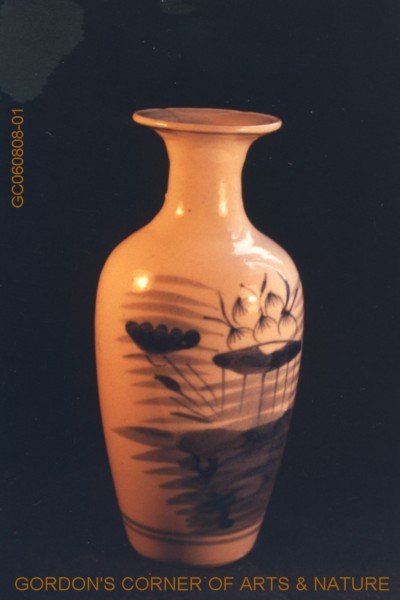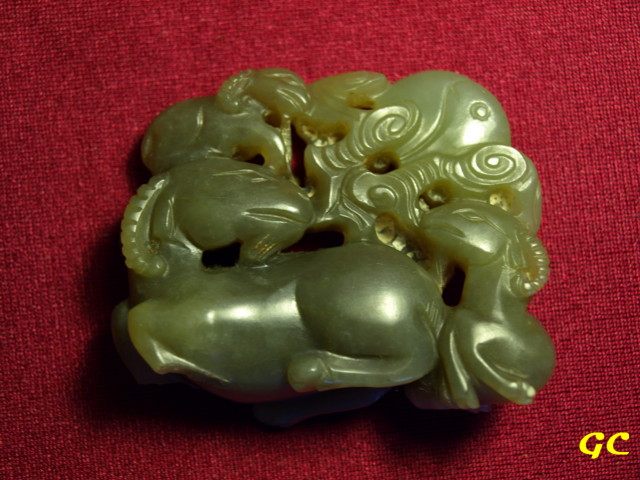CERAMICS
Potteries
The pottery from the Neolithic cultures of northern and southern China is among the earliest pottery about 7,000 B.C.
The other ancient potteries are known in Egypt, Iran, Iraq, Greek and Japan.
The earliest potteries are usually unglazed though some of them have moulded or carved with shallow relief.
The later potteries are painted with geometric motifs in black or purple and reddish brown paints.
In the Shang dynasty (1650-1027 BC), there are evidence of glazing and use of a fine white clay (a forerunner of porcelain).
 However, the Chinese potters began to produce glazed wares for a wide range of items in the Han Dynasty (206 BC-220 AD).
The lead glaze is fired to about 700 °C and becomes glassy.
In this period, the Han potteries have a thin glaze of green or ochre or a thicker glaze of brown.
Some Japanese archaeologist believes that the use of green lead glaze by Han potters originated from the glass technology of the ancient Romans.
Anyway, the glaze is a significant achievement in ceramics.
However, the Chinese potters began to produce glazed wares for a wide range of items in the Han Dynasty (206 BC-220 AD).
The lead glaze is fired to about 700 °C and becomes glassy.
In this period, the Han potteries have a thin glaze of green or ochre or a thicker glaze of brown.
Some Japanese archaeologist believes that the use of green lead glaze by Han potters originated from the glass technology of the ancient Romans.
Anyway, the glaze is a significant achievement in ceramics.
The glaze can be mixed by metal oxides such as iron and tin to produce a
coloured glaze. In the Tang dynasty, the potters used multi-coloured glaze
and the potteries are know as the three-coloured wares. The three-coloured
potteries are widely famous for the figures of horses and camels with non-Chinese riders.
In the Song dynasty, the popular potteries are covered by a white glaze and painted by black motifs.
The green potteries continued to be produced from the Han dynasty to the Song Dynasty,
and became more refined and are classified as Celadon. In the Ming dynasty, cobalt was
mixed into the glaze to produce the very popular blue-on-white wares which were exported
to the Near East and the Europe.
The development of the European pottery started much slower than the Chinese wares. The high-temperature potteries were not manufactured in a large quantity in Germany, Holland, and other European countries until the 17th century. In the 17th to 18th centuries, the European potters often used the Chinese theme to decorate their wares. Many of the wares were made in the Ming blue-white style. The blue-white potteries are still produced in China and are today exported to the whole world.
Antique Porcelain
A piece of art is called an antique if it is at least 100 years old. However, more detailed information is required to determine the value of an antique and there are many pitfalls of fakes.Three types of fakes:
- Deliberate forgeries produced to lead potential buyers into believing that they are purchasing the real thing;
- Redecorated Originals used the original ceramic forms and decorating them at a later date; Survivals that are copies or reproductions widely produced in response to the popularity of an item.
The experienced collectors and art dealers can quickly spot fake porcelain that has the telltales,
such as wrong glazes, incorrect trade marks, wrong shapes, and wrong colour or decoration.
For sophisticated forgeries, the experts can use the laboratory test of thermoluminescence dating.
The test requires drilling holes in the piece to extract 100 mg of sample.
The test could, however, be fooled by a fake piece that is made from ground-up bits of ancient porcelain.
Other forgery techniques include irradiating to age, computer scanning and modeling, and advanced printing of patterns.
Ordinary collectors might not want to pay for laboratory tests.
The following advice is from James N. Spencer of Christie's:
For buying antiques, the most dependent sources should be established curio shops or reliable auctioneers.
Another method is the research of records - where it was sold or bought, who were the buyers or sellers, background and history, etc.
If the source of the piece is unknown, more care should be exercised to examine the work of art to prevent buying fakes.
Source: (Cosmopolitan Magazine (Hong Kong), 1993)
For a quick check, the collectors can examine the mark on the bottom of a piece.
In the United States, a law was passed in 1891 to require all imported ceramics bearing the name of the country of origin on the bottom.
One could quickly estimate the range of years. For example, the popular British porcelains of the
19th Century carry the mark of "England" since 1891. For Chinese porcelains of the Ming and the Qing dynasties, the more expensive pieces carry
the marks of the year of manufacture. For examples, Made in the Yung-lo year (1403-1424) or Made in the K'ang-hsi year of the Great Qing (1662-1772).
SCULPTURES

"A great piece of sculpture is never self-contained; it reaches out to affect the space around it."
«Une sculpture n'est jamais finie en elle-m&ecric;me; elle nous enseigne comment affecter l'espace tout autour.»
— quote of an unknown writer in a French translation textbook
Display - Bronze & Jade Figurines
[Top] [Ceramics][Sculptures][Jelleweries] [Drawings][Photography][Miscellaneous] [Bottom of Page]
JEWELLERY
"Each of us comes to craft work in a different way. Some approach it as a business, and for others it is mostly a personal - sometimes introspective - activity. For all of us, it is to some degree a form of therapy, a chance to stare the world in the eye and say, "I made this."
— Tim McCreight, Jewellery, 1997
Starting from the late 19th century, many painters and sculptors once again took interest in jewellery design as in the
Renaissance. Among them were Braque, Jensen, Picasso and Dali. Some of their designs were described as appropriate and wearable,
while some were termed lavish and extravagant.
Surrealistic artist Salvador Dali (1904-1989) proclaimed:
"My jewels are a protest against the high cost of jewellery materials. My aim is to show the jeweller's art in its true
perspective - where the design and the craftsmanship are of more value than the gems, as in the Renaissance era."
In general, his designs are elegant but somewhat elaborate when compared with the work of other artists-craftsmen. The picture
The Gold Cube Cross (right) is one of his designs in the Collection of Sculptured Jewels by Salvador Dali.
Notes:
Sterling or 925 silver is the most popular material for hand-made jewellery. Sterling silver is defined as 925 parts per thousand; fine silver is 999 parts per thousand and high fine silver is 999.5 pure silver.[Top] [Ceramics][Sculptures][Jellewery] [Drawings][Photography][Miscellaneous] [Bottom of Page]
DRAWINGS
Etching
It is a popular method of making identical prints of drawings created by artists, for example Rembrandt. In this method, a metal plate (usually copper, zinc or steel)
is coated by a waxy paint and a picture is drawn on the paint with a sharp tool to expose the metal beneath the paint.
Then the plate is submerged in an acid bath (often nitric acid). The acid eats into the exposed lines on the plate.
The paint is wiped away from the whole plate, leaving an image on the metal plate. After rinsing and cleaning the plate, etching ink is applied to the plate.
When the plate is wiped, the picture appears as lines (holding the ink). Finally, a moist paper is placed on top of the plate which is run through a press.
The paper lifted from the plate will show an opposite image of the etched lines.
The following YouTube video shows several etching techniques:
For hobbyists, inexpensive materials and tools will often suffice to make some good prints. The following video-link shows how a lithograph print is made using kitchen supplies. [Kitchen Lithography]
Realistic Water Colour Paintings
By Marcello Barenghi (marcellobarenghi.com): [ Ruby]PHOTOGRAPHY
Photographing the Moon

When a celestial body passes in front of another body in the line of sight to an observer on the earth, this results in a temporary obstruction of the view
and is called an occultation. This type of astronomical events is often possible to view in a clear cloudless night with naked eyes.
An ordinary camera can be used using manual modes and low shutter speeds to bring a spectacular picture, though a tripod and longer lenses are required
for better results.
The picture on the right was taken on 26 February 2014 in Toronto, Canada, when the moon and Venus passed before each other.
Settings:
48mm focus length, ISO100, 3.2 sec, F6.3, manual focus.
Left: Venus lower left to the moon Right: Venus upper right to the moon
150mm, ISO200, 1/2.5s, F13 150mm, ISO100, 3.2s, F6.3
Compositing Photographs for Funs and for Artistic Creation
[ Click to read][Top] [Ceramics][Sculptures][Jellewery] [Drawings][Photography][Miscellaneous] [Bottom of Page]
OTHER TOPICS
Elephant Art
Since prehistoric times, man has been drawing pictures of his surroundings — animals, natural events, scenery, etc.
Recent years, people have discovered the ability of domesticated animals to paint.
...
The paintings produced by these animals are basically of abstract nature, except those by the elephants in which there are some artistic elements
comparable to the skills of human novice painters.
[Read More]
Antique Wood Furniture
[1] Modified Dressing Table[2] Rocking Chair
[3] Album-Furniture
Caring for Wood
Because of the warm, natural colour and feel, wood is a treasured material for decorative and functional objects.
In contrast to gold, wood can, however, decay under unfavourable circumstances,
but wood can last for centuries if they have been tended carefully.
There are some tips to keep old wood objects or furniture in the tip-top condition:
- Keep wood from extreme variations in humidity and temperature. In general, use room environment levels. For an overseas purchase, exercise more care to acclimatize the wooden objects, especially from more humid countries to drier climates, and vice versa. For Chinese furniture, keep humidity between 30-50% and a temperature of 10-26.5 degrees Celsius (50-80 degrees Fahrenheit).
- Keep wood out of direct sunlight that will dry out the object and damage its finish.
- Keep away from chemical sprays, spills, stains or serious scratches.
- Use a dry or slightly damp cloth to clean the wood, and use a soft brush on carved areas. The cloth should be soft enough to prevent scratch the finish. Do not use metal-cleaning chemicals to polish the metal ornaments on the wood; only dust them carefully.
- Use a paste wax to protect and nurture the wood. Do not over apply the wax in order to prevent a thick build up of wax. It needs time and gentle rubbing to show a glowing luster of patina on the wood. Use a high quality wax of Carnauba or beeswax. In North America, one can use the natural Minwax Paste Finishing Wax.
- Can try mayonnaise, a common salad dressing in North America, to polish wood when you do not have time to get the proper wax. The vinegar and oil in mayonnaise can clean and temporarily restore the shine of the finish.